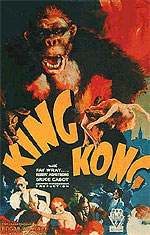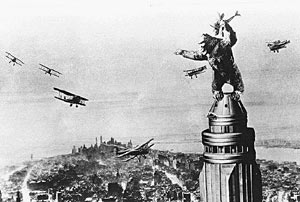|
Ode
to an Ape
The Legacy of King Kong
by A. Jacob Hiebert
He
was a seething, raging, rampaging giant, a hairy beast who
struck terror in the hearts of moviegoers nationwide. His
name was King Kong, and this year marks the 65th anniversary
of the release of the RKO monster horror masterpiece that
was one of the most famous American movies ever made.
 |
| Images
©1933 Turner Home Entertainment Group |
|
King
Kong is the grand-daddy of all monster movies and was so well
made and well written that you can watch it again and again
and always find something new. It was a special effects tour
de force in it's day, costing well over $500,000 to produce
(a whole lot of dough back in 1933) and taking more than two
years to make. Kong began a tradition of high-budget, high tech
suspense thrillers that are still popular today. But more than
a spectacle to behold, King Kong is also a tense, psycho-sexual
drama and a disturbing, dream-like exploration of the human
soul.
The
film revolves around an eccentric movie producer named Carl
Denham (Robert Armstrong), who hears of a place called Skull
Island, where a giant creature, "neither man nor beast," is
said to exist. He hires a ship and a crew and sets sail, hoping
to capture the creature on film. Just before their departure,
Denham finds Ann Darrow
(Fay Wray) hungry and desperate on the mean streets of New
York and convinces her to be his leading lady. Onboard the
ship, Darrow falls in love with first mate Jack Driscol (Bruce
Cabot), but when they reach the Skull Island, she is kidnapped
by the natives and sacrificed to their god, the incredible
Kong. Kong falls in love with Darrow and takes her back to
his treacherous lair. In hot pursuit of the young maiden,
Driscol, Denham and a dozen others encounter a whole slew
of terrifying beasts who also inhabit the island. They rescue
Darrow, capture Kong, and decide to salvage the journey by
bringing the great ape back to Manhattan and putting him on
display. But things go awry when, on opening night, Kong breaks
loose and runs amok, going on a killing spree and carrying
Darrow to the top of the Empire State Building before he is
shot down and falls to his death.
It's
hard to imagine, but King Kong was considered one hell of
a scary film when it was first released. Moviegoers were stunned
by scenes of the mighty Kong biting off people's heads and
trampling them to death in stop-action animated sequences
that, for the time, were startlingly realistic. So shocking
was some of the footage, that a few people in test audiences
walked out in disgust, or because they were physically ill.
Executive producer David O. Selznick decided to remove five
scenes from the movie that were thought to be too much for
many viewers. There is a legend in Hollywood that the five
scenes still exist on celluloid, and many Kong-o-philes dream
of a day when a new, uncut version of King Kong will be released.
Although
viewers were frightened, they were not frightened away. Upon
its release, King Kong played 10 times a day in two New York
City theaters, the Roxy and Radio City Music Hall. It broke
world records for attendance and grossed more than $89,000
in it's first four days, which was crazy money at a time when
a ticket set you back some 15 cents. Not until the release
of Star Wars would another high-tech movie affect audiences
so profoundly.
Besides
being a sensational story, the Kong narrative is both thoughtful
and ingenious. Watch closely and you will find intriguing
duelisms hinging on the plot. Darrow and the Monkey are like
the yin and yang of a great psychic drama. He is massive,
hard and irrepressible, while she is small, soft and irresistible.
Kong's mysterious island home is set off against Manhattan
in the throes of the Great Depression. Both are dark, dangerous
places, but one is a bastion of primitive savagery and the
other the very throne of modern civilization. In Kong's domain,
Darrow is in bondage. In Darrow's New York, Kong is enslaved.
 |
| Images
©1933 Turner Home Entertainment Group |
|
But
one the most significant features of King Kong is that the Great
Ape has a character that is decidedly human. Director Merian
C. Cooper, on the advise of screenwriter Ruth Rose, emphasized
the tragedy of unrequited love in Kong's predicament, and made
the monster sympathetic as well as terrifying. At the end of
the story, when Kong finds himself trapped atop the Empire State
Building, he appears overcome by a deep sadness, as though he
understands that he is about to die. He touches an open wound
over his heart and looks at the blood thoughtfully. Then he
gently puts Darrow down in a safe place, seems to say goodbye
to her, and, like a brave warrior, takes one last stab at his
enemy before plummeting to his tragic end. (Perhaps the most
poignant aspect of the film is that this captivating swan song
was not performed by an actor, but rather created by an animator
with a puppet made of foam rubber and rabbit fur.)
Many
actors who portrayed monsters in the '30s and '40s owed much
to the great ape for showing how the most horrific creatures
can reflect a bit or our own humanity back at us. When Boris
Karloff portrayed the Frankenstein monster, viewers were sympathetic
to the beast's hideous fate. The same could be said for Lon
Chaney's Werewolf and Charles Laughton's Hunchback of Notre
Dame. All of these movie monsters had more substance to them,
more soul, and a significant dose of pathos, thanks to one
giant, delinquent gorilla.
Alas,
the legacy of the all-too-human Kong is slowly withering
away. Today's movie monsters are decidedly inhuman.
From the creature in Alien, to the extraterrestrials
in Independence Day, the contemporary monster reflects
a new kind of neurosis. Today, we conjure up blank-faced,
zombie-like, impartial killers to match the malaise
of soulless modernity. Back in '33, as society recovered
from Victorian hypocrisies and wrestled with its
love of demon rum, a fascination with war and the
stupidity of societal inequities, the passionate
Kong served as a symbol of the most repressed and
feared aspects of the human consciousness. Righteous
and stampeding desire may well be what people feared
most in the Thirties. Certainly, this same fear
led some people to believe that swing was 'the devil's
music.' Today, we like to think that we have successfully
integrated passion and desire into our collective
psyche, but in truth, we still live in an emotionally
repressed society. For this reason, King Kong still
speaks to us, and we can still recognize, in Kong,
the beast within.
|










